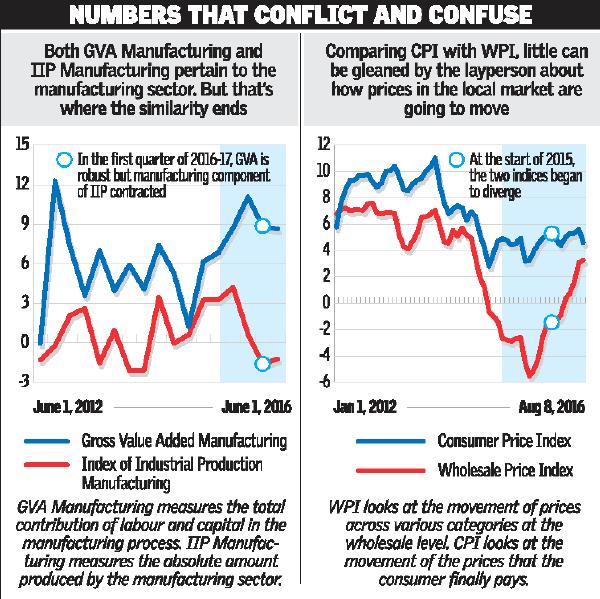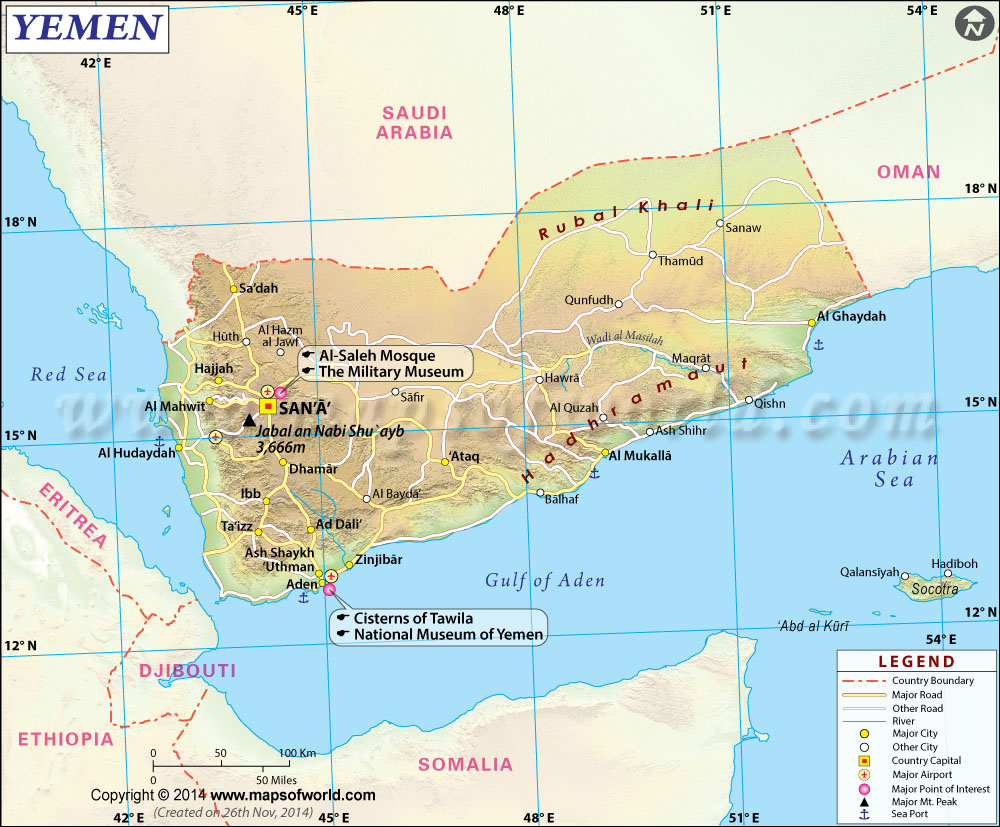IASbaba's Daily Current Affairs Analysis, IASbaba's Daily Current Affairs Oct 2016, International, UPSC
Archives
IASbaba’s Daily Current Affairs – 12th October, 2016
ECONOMY
TOPIC: General Studies 3
- Indian Economy and issues relating to planning, mobilization of resources, growth, development and employment.
Indian Economy: How is it Performing?
The health of Indian economy can be measured in multiple ways. But, each metric points in a different direction. Is it reliable to show the real picture of Indian economy?
- The Gross Domestic Product and Gross Value Added (GVA) are both above 7%, hence it can be said the economy is growing strongly.
- But, the Index of Industrial Production (IIP) has contracted for two straight months. It means that India is actually not doing so well.
- Another indicator can be corporate and personal income tax collections. But it is not necessary that they reflect true picture of government revenues.
Thus, different indicators align in different directions to conclude the health of economy. Adding to the confusion, almost every metric put out by the government is incompatible with every other metric, even if they pertain to the same sector!
Differing results
GVA and IIP
- If we compare GVA in the manufacturing sector to the manufacturing component of the IIP, at the outset, it can be said that both pertain to the manufacturing sector. But the similarity ends here.
- While the IIP Manufacturing measures gross output (the absolute amount produced by the manufacturing sector), GVA Manufacturing measures the total contribution of labour and capital in the manufacturing process. This is completely different from gross output.
- In the first quarter of financial year 2016-17, the GVA manufacturing was very robust at 9.1%. However, the IIP manufacturing component contracted by about 0.8% in the same period.
- For a common person to understand, it provides a contradictory picture. Total output is shrinking, but more value is being added to that output. How is it possible and how to determine if the sector is progressing or not?
Actual measurement
- The IIP uses the figures of 2004-05 as the base year.
- On the other side, other metrics like GDP, GVA and the inflation indices have moved to a more recent base year of 2011-12.
- Comparing the results of both the indices is not a wise choice.
Inflation
- Two sets of numbers are released every month by the government- WPI and CPI
- WPI looks at the movement of prices across various categories at the wholesale level whereas CPI looks at the movement of the prices that the consumer finally pays.
- These indices moved in tandem for a while but at the start of 2015, they began to diverge.
- In September 2015, at the height of their divergence, there was a 9 percentage point difference between the two indices. CPI was at 4.4% and WPI was near the same, but in negative.
- This does not explain how the prices in the local markets are going to act.
Tax collections
- Tax collections are also a useful metric to gauge income growth due to the assumption that if corporate and personal income goes up, then so will the government’s tax collections.
- However, it is often forgotten that only 5.5% of the earning population pays income tax. Adding to it, a large chunk of corporates gets away with paying zero tax thanks to the various exemptions and tax havens they can avail of.
- Thus, any conclusion made from tax collection may mislead where the economy is going.

Picture Credit: http://www.thehindu.com/multimedia/archive/03041/th12_new_GVA_3041017a.jpg
Periodicity of data releases
- The data undoubtedly important for policy and transparency viewpoint and that is why government releases industrial data.
- But such an exercise and effort seems futile when it is released on monthly basis as nothing can be perceived from such small period of data.
- Instead, for a more reliable analysis, a longer period of time is required. For example data, of say, a quarter can be compared for better prediction of where the economy is heading.
- It is very difficult, time consuming to aggregate such large data of entire country’s industrial performance and agonise over monthly variations of indices.
Ending note
- The monthly figures hardly provide any inputs of economic performance. The IIP numbers since 2011 has a standard deviation of 3. It means, how much any given month’s performance can vary from the average. Such huge deviations can derive nothing when data swings so wildly on a monthly basis.
- The data collection efficiency is equally important to come at emerging economic picture. However, there is no proof that data collectors of the Ministry of Statistics are efficient enough to provide accurate data.
- Hence, there should be application of Government Inefficiency Discount to data collection as well. It will further help to know the truth of the numbers being put out.
- Thus, for now, it cannot be said how the economy is doing based on such divergent results.
Connecting the dots:
- What are different measures used by government of India to determine economic growth? Explain.
- Different indices to measure economic growth is a reliable way to understand the overall picture. However, these measures have to be in tandem rather than diagonally opposite to avoid confusion. Substantiate.
Related articles:
INTERNATIONAL
TOPIC: General Studies 2
- Bilateral, regional and global groupings and agreements involving India and/or affecting India’s interests
- Effect of policies and politics of developed and developing countries on India’s interests, Indian diaspora.
What is happening in Yemen and what should be India’s role?
Story till now
- In March 2015, several wealthy Arab nations together started a bombing campaign against the poorest Arab nation: Yemen. The coalition was led by Saudi Arabia, and backed by the US.
- The war stranded over 4,000 Indians in Yemen, and prompted India to launch Operation Raahat, a highly successful airlift that won New Delhi international attention and kudos.
- The bombings faded from the headlines. But again in first week of October 2016, Saudi Arabia bombed Yemen which killed 140 people, most of which were non-combatants.
- This stirred the US administration’s conscience which prompted it to say that it was reviewing its participation in the war, and warned Saudi Arabia not to expect a ‘blank cheque’ to conduct its campaign.
Picture Credit: http://www.mapsofworld.com/indexmaps/yemen-map.jpg
Background:
- The Saudi Arabia’s target in Yemen has been Houthi militia which had taken control of large swathes of Yemen, including its capital, Sana’a.
- Saudi Arabia led coalition aimed to return power to the country’s president, Abd Rabbuh Mansur Hadi. But that had a sectarian and geopolitical subtexts to the war.
- The coalition was made up of Sunni-majority nations, and the Houthis are adherents of a kind of Shia Islam.
- For Saudi Arabia, which regards Shia Islam as its opponent, the prospect of a Shia uprising along its southern border was intolerable. Even more alarming for its dominance was that the Houthis were being backed by its old rival, Iran.
- The war by coalition was mainly air strikes where Arab states’ expensively assembled air forces had total domination and they were backed by US’s logistical and intelligence support. On the other hand, Houthis had no planes and Iran was never going to send air squadrons to support them.
- This made the Saudi Arabia and its allies confident of ending the war in weeks, or at most, months.
- But the fact that the war continues to rage till today is a matter of profound humiliation for the Arab states, whose military forces, built to combat domestic dissent from unarmed political activists, have proven incapable of subjugating an enemy that fires back, even with inferior weapons.
- For Iran, the cost in Yemen is small but the benefit is substantial. It keeps Saudi Arabia in check and distracting them from the larger geopolitical challenge. From time to time, Iran has also sought to use the conflict in Yemen to deflect attention from its own participation in the carnage in Syria.
Yemen has been destroyed in war
- Already one of the world’s poorest nations, it has been reduced to abject destitution. The war has been calamitous for Yemen
- More than 3,600 people have been killed. Millions have been made homeless.
- The World Food Programme has warned that the country is on the brink of famine, and Amnesty International reckons that 83% of the population depends on humanitarian assistance for survival.
- The Houthis, for whom this conflict had begun as a quest for greater autonomy in the country’s northern part, now find themselves responsible for a desperate population.
The threat intensifies
- The war has made mockery of political calculations. The US Navy recently said that one of its destroyers off the coast of Yemen had been attacked by two missiles, fired from Houthi-controlled territory.
- In another instance, Saudi Arabia said one missile was fired at its airbase. Though the missiles fell harmlessly into the sea and created no casualties at airbase, it projected dangerous turns into the war.
- The Houthis have not previously been known to possess such firepower. Hence, Iran will be obviously pinpointed.
- The US worries about the potential for these weapons to fall into the hands of Al-Qaeda’s Yemeni operation where, it has taken advantage of the chaos and expanded its territorial control.
Responding as a community
- It has been a depressed observation that world community is no longer unfazed by disastrous wars and disasters happening in other parts of the world. The starving kids, the bombed civilian places, destroyed homes evoke no strong response from the world communities.
- They have considered such ‘news’ as a routine and failed to exercise a second look deep into the matter.
- Thus, for India, to become a world leader, it has to evolve itself by addressing such matters. Indian media has to look beyond US and focus attention on global issues which are impacting everyday life of people in countries like Yemen.
- India’s civil society and social movements have been theoretically acute and organisationally substantial on issues like the right to information and the need of biotechnology but has failed to represent local and international issues like reinventing the UN and its idea of peacekeeping.
- India has to step out and take stands on starvation, rights, energy, violence and sustainability without being knee-jerk and imitative. This reiterates its domestic policies and focus on such issues in domestic context.
- In terms of responses to Syria, Afghanistan, Somalia, Yemen, India has been complicit with the West or tongue-tied. India does not need to wait for the actions and reactions of the west and form its responses.
- India has to be more empathetic with the downtrodden and should not distance itself from what the West calls “the failed societies” of Asia and Africa, from the fear of being painted with the same brush.
- There is a need for strong activists such as Bertrand Russell who created with great courage a tribunal to try the U.S. for war crimes in Vietnam and Noam Chomsky who also followed the suit. Today, few have the courage to demand and label the U.S. and Saudi Arabia for a crime against humanity.
- India has to respond as a community. Caring has to go beyond aid to create a new sense of community. Few aerial rescues are not worth the constant accolades but help is required in terms of moral support and active support for people of destroyed countries like Yemen and Syria.
- India has to uphold its democratic principles and not replicate the American need for hegemony and its lack of political ethics.
Connecting the dots:
- Countries like Yemen and Syria are facing worst humanitarian crisis. But the world has hardly shown solidarity for them. Can India play any role in such international matters? Give reasons.
- India aims to become world leader-economically and politically. But for that, it has to move beyond US and China. Do you agree? Substantiate.
MUST READ
Military fables of a democracy
Bandwidth for growth
India unhappy over Russia-Pakistan ties
HIV Bill offers steps to end discrimination and ensure equality for affected groups
Pakistan’s India policy stems from false religious antagonism
Govt, Law Board: Framing the Triple Talaq argument
The ethics of our AI-enabled future
Call for a multilateral competition regime
It isn’t enough to focus on Doing Business rankings
UPI 2.0 will disrupt payments in India
Early childhood development should be a priority for India
Big changes for small units under GST













